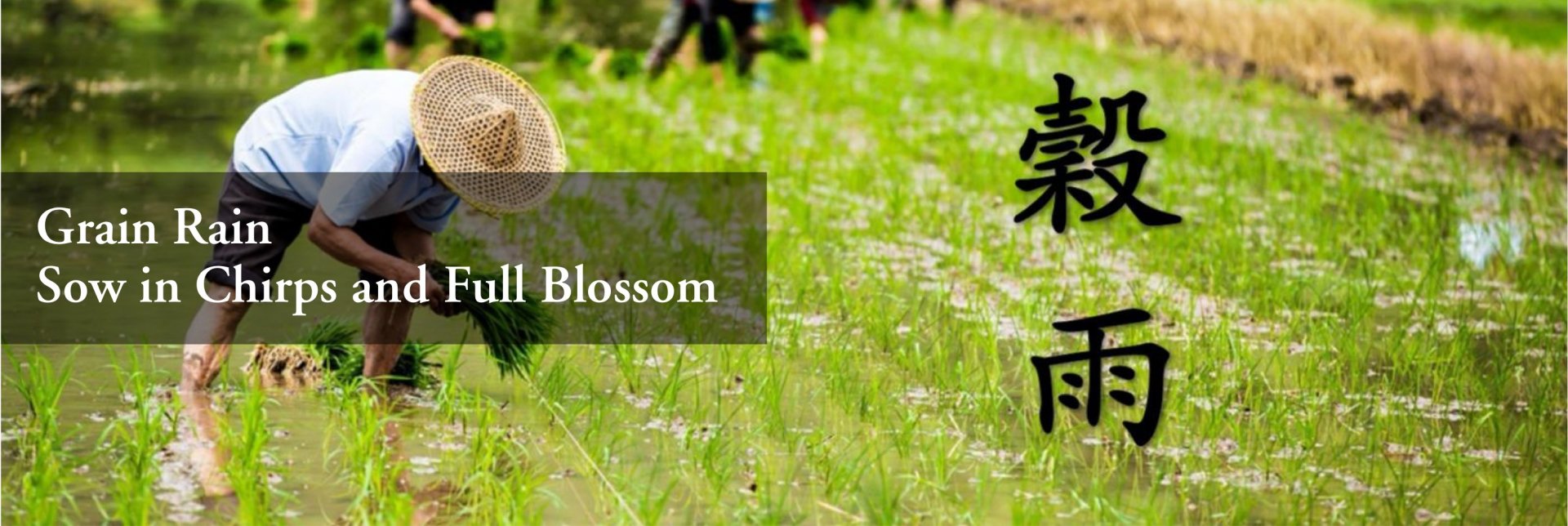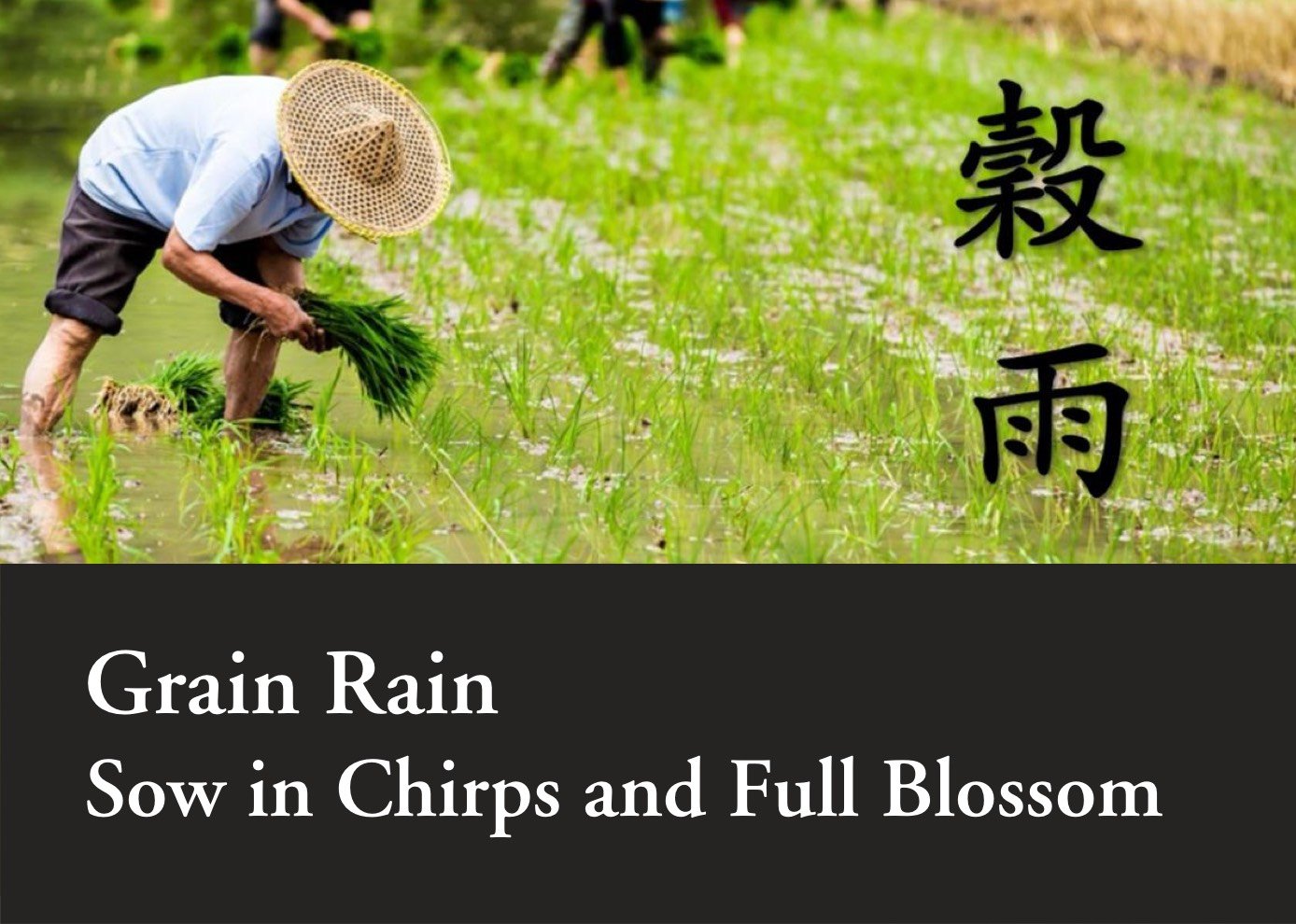Grain Rain: Sow in Chirps and Full Blossom
As a widespread saying goes, “Mice can die of chill during Qingming and Grain Rain.” Especially in South China where rainy and dank days are common, cold waves from North China come now and then at this time of year. Thus even the gentle third lunar month in spring is inevitably cold, which is usually called “Cold Spell in Late Spring”(倒春寒). Nonetheless, as the last solar term in spring, Grain Rain sees a more significant rise in temperature, faster growth of all creatures, and busier farmers. We can tell from the relevant popular sayings, like “Never slight Grain Rain and catch up on planting hydrophytes”, “Grain Rain is precious with abundant rainfall”, etc.

The ancients believed that various natural signs serve to remind us of farming during Grain Rain. According to Book of Zhou:Lesson of Solar Terms (逸周書•時訓解), the second sign of Grain Rain is turtle doves flapping and tweeting to urge farmers to sow corps timely; the third sign is hoopoes fall on mulberry branches often to remind peasant women of picking mulberry leaves and breeding silkworms. Farming and collecting silk have been attached great importance to since ancient times. The former emphasizes cultivation, and aims at feeding people. The latter emphasizes textiles, and aims at dressing people. Without worries about feeding or dressing, a society can be described as moderately prosperous. Chao Cuo (晁錯, 220 – 154 BC) in Han dynasty wrote in the beginning of On Cherishing Grains (論貴粟疏) that a sage ruler has two main merits, one being his people away from cold, the other being his people away from hunger. Poet Tao Yuanming (陶淵明, 356 - 427) in Eastern Jin dynasty wrote in Persuade Peasants (勸農) that spring is short, hence we should cherish time and persuade people to work hard, which includes two aspects: one is that farmers should be busy with their fields, the other is that peasant women should get up early to pick mulberry leaves and breed silkworms. The term Grain Rain means “Rain gives birth to various grains” or “To sow when rain falls”. Either way, it’s time for cultivation. Only when men cultivate while women weave busily following the natural rhythms can we get a good harvest over the year.

Like the peasants who live on farming and silkworm breeding, tea planters are busy with collecting and processing fresh tea. Pre-Qingming Tea (明前茶) has been well-known. Yet Grain Rain Tea (穀雨茶), aka Mid-spring Tea (二春茶), is also widely celebrated. Among a diversity of tea, two premium varieties belong to Grain Rain Tea, i.e. Flagged Spear (旗槍, stir fixed green tea) and Sparrow Tongue (雀舌, young buds roasted green tea). When brewed with hot water in a pot, Flagged Spear unfolds and looks like an ancient spear attached with a flag, each spear with a bud. By contrast, Sparrow Tongue looks like a sparrow’s tongue, tender and delicate, each spear with two buds. Compared with Pre-Qingming MingTea, Grain Rain Tea comes later, yet is maturer, tastes stronger and lasts longer. Unlike the expensive Pre-Qingming Tea, Grain Rain Tea is affordable and thus more popular among average tea lovers. In addition, there is a folk custom to drink tea on Grain Rain, and numerous ingenious usages of Grain Rain Tea, such as heat-clearing and improving eyesight. The initiative of stipulating Grain Rain as National Tea Day by China Tea Science Society together with other authorities may also relate to these merits of Grain Rain Tea.

Grain Rain is a romantic solar term. Legend has it that the term relates to Cang Jie (倉頡, 2667-2596 BC), the founder of Chinese characters whose incomparable merits and virtues moved nature and brought a grain rain. Poet Su Shi (蘇軾, 1037-1101) also wrote in On Rain Delight Pavilion (喜雨亭記) that when he was just assigned as a local officer in Fengxiang(located in Baoji City, Shanxi Province, China), a wheat rain fell to the south of Mt. Qi, which indicated a promising year. The best wishes are like blossoms along the way and add fancy to spring.
There are also romantic customs during Grain Rain in real life. As a saying goes, “Peonies can be enjoyed in the garden three days after Grain Rain.” Isn’t it a pleasant scenery in the blessed time, and a cheerful event with a romantic atmosphere? Therefore, peonies are titled Grain Rain Flower. As the first two lines in White Peony (白牡丹) by poet Wang Zhenbai (王貞白, 875-958) in Tang dynasty, “Rinsed by Grain Rain, the tiffany is cut into white peonies.” Then he gave a vivid description of the aroma, shape and tone of white peonies. Peonies are national beauty with heavenly fragrance. Yet due to the climate factors, they would not blossom until the third lunar month in late spring. So, peonies are credited as “Never overshadowing other flowers”.

Even in the modern society, enjoying peonies in the third lunar month remains a popular event. During the spare time, people would hike to admire the beauty of flowers, or write odes to peonies, both of which contain the life philosophy and wisdom of balancing work and life in our traditional culture.
參考資料:
Journal Article
1. 張建:〈「穀雨」舉隅〉,《昭通學院學報》,第4期(2019年)。
News or Magazine Article
1. 侯雪靜:〈穀雨:雨生百穀〉,《新華每日電訊》,2022年4月20日,第4版。
2. 淩鶴:〈雨潤萬物百穀生〉,《遼寧日報》,2022年4月22日,第8版。
3. 董國賓:〈穀雨讀詩〉,《語言文字報》,2020 年4月22日,第4版。
All articles/videos are prohibited from reproducing without the permission of the copyright holder.




Welcome to leave a message:
Please Sign In/Sign Up as a member and leave a message很美的作品!多謝分享。
#1
Chi Seng Pun
22-04-2023 16:30:40